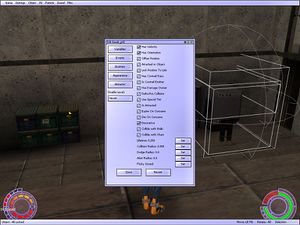level0_Tools
During the development of Oni, Bungie West had an in-game editor for real-time creation and adjustment of entities in the game world. The editor could only run in a "tool build" of the Oni application named OniTool.exe, which we do not possess. The UI resources for the editor were stored in files called level0_Tools.dat/.raw[/.sep]. The tool files also contain other resources that were used during development as well as textures that are seemingly relics not meant to be released.
These files were first discovered in the German localization of Oni for the Mac, but have subsequently been found in the rest of the Mac (E)FIGS localizations, Japanese Oni for both Windows and Mac, and Final Candidate build 7 (Windows, English). The labels on the elements in these windows were helpful in reverse-engineering the BINA formats.
A standard Oni application will not load these files (in fact, Oni will explicitly state in its startup log that it is 'skipping the tool files' if it sees them in the GDF), but by replacing existing WMDDs in the game with tool WMDDs (and supplying the alternate PSUI intended for Tool Mode), Oni can be tricked into displaying the Tool Mode windows, even though they have no functionality. This is how screenshots of the interface were obtained.
Selected windows can be seen in this category, but a complete collection of all 70 images in one place is found in this directory. If you're curious about looking at the files' resources, you can download level0_Tools here. OniSplit can be used to extract and convert the .oni files, just the same as with levelx_Final files.
Here is an overview of level0_Tools' contents:
- WMDDs that were used by the in-game visual editor, a.k.a. Tool Mode. As mentioned above, this mode is not available in a release build of Oni. Bungie West used it to edit OBJCs and other BINA resources while test-playing the game. When you read an OBD page for a resource type that had an editor window, you will see a picture of the window at the bottom of the page.
- Distinct furniture models (OFGAs), instances of which could be placed/adjusted while in Tool Mode. In Windows/Mac Oni, the furniture was baked into Oni's levels, i.e., converted to static quads in the AKEV, before shipping, but the PS2 version's furniture still consists of independent mesh instances.
- Textures that were used for debugging or other obsolete purposes. The most notable texture is probably the cartoon cat we have named Hapecat; this is a variant of the character who appears in a poster in Chapter 4, who has become something of a mascot for the community.
- Historical note
Back when these WMDDs were discovered in German Oni, it was quickly realized that the localizers had translated some portions of the Tool Mode dialogs into German along with other resources, not understanding that they were unused by the game. Thus our first look at the editor UI was after somewhat-clueless localizers attempted to translate some English labels into German, which fans then back-translated into English. Eventually an original English set of WMDDs were recovered from a final release candidate build of Oni, giving us the authentic text for the dialogs.
